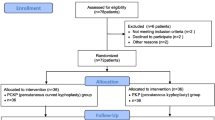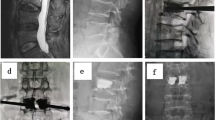Abstract
Summary
Many previous studies have reported excellent clinical results with percutaneous kyphoplasty (PKP). In contrast, numerous complications and problems have also been reported, such as puncture difficulty, cement leakage, and adjacent vertebral fracture.
Introduction
This study is to evaluate the application and clinical outcomes of unilateral transverse process-pedicle and bilateral PKP in the treatment of osteoporotic vertebral compression fractures (OVCF).
Methods
A total of 56 cases with two levels thoracolumbar OVCF were randomly assigned for treatment with unilateral transverse process-pedicle and bilateral PKP. The patients were followed up postoperatively and were assessed mainly with regard to clinical and radiologic outcomes. Clinical outcomes were evaluated with mainly the use of a visual analogue scale (VAS) for pain. Radiologic outcomes were assessed mainly on the basis of radiation dose and bone cement distribution.
Results
The operation was completed successfully in 56 cases. In the unilateral level, the operation time, the volume of the injected cement, and radiation dose were significantly less than bilateral level. All patients had significantly improvement on VAS score after the procedures, compared with their preoperative period. In the bilateral level, 7 patients had obvious pain in the puncture sites at 1 month postoperatively caused by facet joint violation. With local block treatment, the pain disappeared in all patients at the last follow-up.
Conclusion
Both bilateral and unilateral PKP are relatively safe and effective treatments for patients with painful OVCF. But unilateral PKP received less radiation dose and operation time, offered a higher degree of deformity correction, and resulted in less complication than bilateral.




Similar content being viewed by others
References
Klazen CA, Lohle PN, de Vries J, Jansen FH, Tielbeek AV, Blonk MC, Venmans A, van Rooij WJ, Schoemaker MC, Juttmann JR, Lo TH, Verhaar HJ, van der Graaf Y, van Everdingen KJ, Muller AF, Elgersma OE, Halkema DR, Fransen H, Janssens X, Buskens E, Mali WP (2010) Vertebroplasty versus conservative treatment in acute osteoporotic vertebral compression fractures (VERTOS II): an open-label randomised trial. Lancet 376:1085–1092
Rousing R, Hansen KL, Andersen MO, Jespersen SM, Thomsen K, Lauritsen JM (2010) Twelve-months’ follow-up in forty-nine patients with acute/semiacute osteoporotic vertebral fractures treated conservatively or with percutaneous vertebroplasty: a clinical randomized study. Spine 35:478–482
Kallmes DF, Comstock BA, Heagerty PJ, Turner JA, Wilson DJ, Diamond TH, Edwards R, Gray LA, Stout L, Owen S, Hollingworth W, Ghdoke B, Annesley-Williams DJ, Ralston SH, Jarvik JG (2009) A randomized trial of vertebroplasty for osteoporotic spinal fractures. N Engl J Med 361:569–579
Buchbinder R, Osborne RH, Ebeling PR, Wark JD, Mitchell P, Wriedt C, Graves S, Staples MP, Murphy B (2009) A randomized trial of vertebroplasty for painful osteoporotic vertebral fractures. N Engl J Med 361:557–568
Rousing R, Andersen MO, Jespersen SM, Thomsen K, Lauritsen J (2009) Percutaneous vertebroplasty compared to conservative treatment in patients with painful acute or subacute osteoporotic vertebral fractures: three-months’ follow-up in a clinical randomized study. Spine 34:1349–1354
Chen YJ, Tan TS, Chen WH, Chen CC, Lee TS (2006) Intradural cement leakage: a devastatingly rare complication of vertebroplasty. Spine 31:379–382
Cosar M, Sasani M, Oktenoglu T, Kaner T, Ercelen O, Kose KC, Ozer AF (2009) The major complications of transpedicular vertebroplasty. J Neurosurg Spine 11:607–613
Fribourg D, Tang C, Sra P, Delamarter R, Bae H (2004) Incidence of subsequent vertebral fracture after kyphoplasty. Spine 29:2270–2277
Barr JD, Barr MS, Lemley TJ, McCann RM (2000) Percutaneous vertebroplasty for pain relief and spinal stabilization. Spine 25:923–928
Heini PF, Wa Ichli B, Berlemann U (2000) Percutaneous transpedicular vertebroplasty with PMMA: operative technique and early results. A prospective study for the treatment of osteoporotic compression fractures. Eur Spine J 9:445–450
Frankel BM, Monroe T, Wang C (2007) Percutaneous vertebral augmentation: an elevation in adjacent-level fracture risk in kyphoplasty as compared with vertebroplasty. Spine J 7:575–582
Mathis JM (2006) Percutaneous vertebroplasty or kyphoplasty: which one do I choose. Skeletal Radiol 35:629–631
Crandall D, Slaughter D, Hankins PJ, Moore C, Jerman J (2004) Acute versus chronic vertebral compression fractures treated with kyphoplasty: early results. Spine 4:418–424
Grohs JG, Matzner M, Trieb K, Krepler P (2005) Minimal invasive stabilization of osteoporotic vertebral fractures: a prospective nonrandomized comparison of vertebroplasty and balloon kyphoplasty. J Spinal Disord Tech 18:238–242
Shindle MK, Gardner JM, Koob J, Bukata S, Cabin JA, Lane JM (2006) Vertebral height restoration in osteoporotic compression fractures: kyphoplasty balloon tamp is superior to postural correction alone. Ostoporosis Int 17:1815–1819
Yang YM, Ren ZW, Ma W, Jha R (2013) Current status of percutaneous vertebroplasty and percutaneous kyphoplasty—a review. Med Sci Monit 19:826–836
Urrutia J, Bono CM, Mery P, Rojas C (2008) Early histologic changes following polymethylmethacrylate injection (vertebroplasty) in rabbit lumbar vertebrae. Spine 33:877–882
Acknowledgments
Dr Dingjun Hao and Dr Baorong He contributed equally to this work and should be considered as co-corresponding authors.
Author information
Authors and Affiliations
Corresponding authors
Ethics declarations
Conflicts of interest
The authors declare that they have no competing interests.
Ethical approval
The study protocol was approved by the Institutional Review Boards and the Ethics Committees of Hong Hui Hospital, Xi’an Jiaotong University.
Informed consent
Before surgery, informed consent was obtained from all patients after a full explanation of the therapeutic procedure.
Rights and permissions
About this article
Cite this article
Yan, L., He, B., Guo, H. et al. The prospective self-controlled study of unilateral transverse process-pedicle and bilateral puncture techniques in percutaneous kyphoplasty. Osteoporos Int 27, 1849–1855 (2016). https://doi.org/10.1007/s00198-015-3430-5
Received:
Accepted:
Published:
Issue Date:
DOI: https://doi.org/10.1007/s00198-015-3430-5




